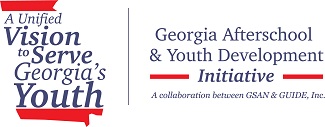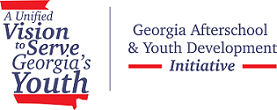The Georgia ASYD Quality Standards highlight the important components of high quality programs and are based on national research and best practices.
Georgia ASYD Quality Standards Assessment Tool
Georgia’s standards come as a self-assessment tool to guide programs in improving their quality.
Fillable Georgia ASYD Quality Standards Assessment Tool
Georgia’s standards come as a self-assessment tool to guide programs in improving their quality. This version may be used to fill in the assessment electronically.
Georgia ASYD Quality Standards Booklet
This booklet will guide you through Georgia’s ASYD Quality Standards.
Georgia ASYD Quality Standards
Quality Element 1: Programming & Youth Development
GUIDING PRINCIPLE:
A quality program designs and implements a flexible, well-rounded daily schedule that supports the physical, social, and cognitive development of all youth by providing programming and activities that are well-organized, developmentally appropriate, and offer opportunities to gain new knowledge and skill
1.1 Promotes a strength-based approach to programming that fosters the relationships, opportunities, and personal qualities that youth need to thrive
1.2 Offers project-based, experiential and hands-on activities
1.3 Ensures that youth experience a balance of group sizes across the program day
1.4 Provides activities that feature an array of instructional approaches
1.5 Offers access to materials that effectively support program activities and meets staff and youth needs
1.6 Solicits and incorporates youth voices in the planning, development & implementation of programming
1.7 Integrates opportunities that foster responsibility, autonomy and leadership throughout the program
1.8 Includes opportunities for reflection and promotes critical thinking and problem solving skills
1.9 Includes opportunities for youth to build like skills
1.10 Promotes self-competence and teaches youth responsible decision-making
1.11 Incorporates opportunities for youth to gain competency in STEAM (science, technology, engineering, arts and mathematics) and music
1.12 Ensures that programming is culturally appropriate and linguistically sensitive
1.13 Provides opportunities for college, career readiness, vocational preparation, and workforce development
1.14 Includes opportunities for youth to engage in international education and gain global competency
Quality Element 2: Linkages with the School Day
GUIDING PRINCIPLE:
A quality program communicates and collaborates with school personnel to ensure that afterschool programming and activities complement and support school day learning, support performance standards, and build strong content knowledge and academic skills in youth.
2.1 Establishes and maintains strong and intentional links to the school day
2.2 Supports Georgia Common Core Standards and local performance benchmarks
2.3 Provides hands-on learning opportunities for participants to develop knowledge in content areas that complement the school day
2.4 When appropriate, incorporates academic support, including homework assistance and/or tutoring
2.5 Ensures that youth develop key academic skills, including research and study skills
Quality Element 3: Environment & Climate
GUIDING PRINCIPLE:
A quality program provides a safe, clean, and developmentally appropriate environment that meets the physical needs of all youth; supports best practice programming, and reflects the needs and interests of youth.
3.1 Has a physically safe and clean environment
3.2 Ensures that the space, equipment, and materials are suitable for the ages and skill levels of youth and meet the program’s needs
3.3 Adheres to state and local licensing requirements
3.4 Supports youth in navigating the learning space independently, taking initiative, and exploring their interests
3.5 Offers frequent access to nature and/or an outdoor space when possible
3.6 Has a physical environment that reflects the work and interests of youth and the programs’ activities
3.7 Allows for the inclusion and engagement of differently-abled youth
3.8 Reflects and incorporates the culture and language of youth and their families
3.9 Provides intentional character education and opportunities for moral action that promote core values in all domains of youths’ lives
Quality Element 4: Relationships
GUIDING PRINCIPLE:
A quality program fosters and nurtures positive relationships and interactions among staff, youth, families, and communities; provides a tolerant and respectful environment that is safe from teasing, bullying, and violence; and promotes diversity.
4.1 Builds positive relationships with youth that are supportive and nurturing
4.2 Ensures that staff are role models of positive and respectful adult relationships
4.3 Incorporates relationship-building opportunities among peers and ensures that youth interact with one another in positive ways
4.4 Teaches and encourages use of conflict resolution skills among youth
4.5 Reinforces positive behavior and employs strength-based techniques to address behavior issues
Quality Element 5: Health & Well Being
GUIDING PRINCIPLE:
A quality program supports and promotes the social and emotional needs of youth, is committed to diversity, tolerance and inclusion, and provides opportunities for youth to be physically activity and learn and practice healthy habits.
5.1 Provides a socio-emotionally safe and supportive environment that is free of bullying and harassment for youth
5.2 Offers regular opportunities for youth to engage in physical fitness and build health and nutrition knowledge and skills
5.3 When suitable to program duration, incorporates nutrition snack and/or meal options, if provided
5.4 Communicates with families to ensure that staff are aware of the individualized needs and special health concerns of youth
5.5 Seeks to connect families and caregivers with information and community resources to support the well-being of families and youth
Quality Element 6: Staffing & Professional Development
GUIDING PRINCIPLE:
A quality program employs staff and volunteers who value each youth, understand youths’ developmental needs, and develop working relationships with coworkers, youth, families and caregivers and other partners. A quality program supports the professional growth of staff and volunteers by providing ongoing professional development that bolsters the knowledge and skill necessary for implementing best practice programming.
6.1 Utilizes a performance evaluation system for staff and volunteers and provides appropriate supervision support and feedback
6.2 Offers all staff and volunteers ongoing professional development and fosters a commitment to continual growth
6.3 Ensures that staff and volunteers are competent in academic and skill-based domains, as appropriate to their positions
6.4 Trains staff to plan and implement programming and activities that are appropriate for the age, skill level and interests of youth
6.5 Monitors and maintains staff-to-youth ratio as per state and local regulations
6.6 Holds regular staff meetings
6.7 Offers training to ensure compliance with OCGA 19-7-5(c) (1) (Mandated Reporter of Child Abuse or Neglect)
Quality Element 7: Organizational Practices
GUIDING PRINCIPLE:
A quality program has a clear mission and well-defined goals, sound fiscal management, and clear policies and procedures that support quality and sustainability.
7.1 Clearly defines the organizations’ mission, vision, values and goals and aligns this framework with specific outcomes to measure progress
7.2 Develops and employs an employee handbook that specifies internal policies and procedures
7.3 Establishes program policies and procedures and makes them available to families and caregivers and stakeholders
7.4 Establishes and maintains clear attendance and participation expectations
7.5 Maintains a system for the collection and monitoring of youth attendance data
7.6 Has a disciplinary protocol and makes clear the expectations for youths’ behavior
7.7 Maintains confidential records on all youth and ensures records are up-to-date
7.8 Adheres to state and local licensing requirements (e.g. health certificate, security clearance, insurance, etc.)
7.9 Maintains a sound budget; reviews and adjusts budget periodically and as necessary
1.10 Completes all required reports and submits them in a timely manner
7.11 Ensures that lesson plans are available and accurate, and the program schedule and room assignments are posted
Quality Element 8: Evaluation & Outcomes
GUIDING PRINCIPLE:
A quality program has measurable program and outcomes-based goals; and a system and plan in place for gathering data, engaging in data- driven decision-making, implementing program improvement strategies, and regularly reassessing outcomes.
8.1 Delineates measurable program goals and objectives that reflect the organization’s mission
8.2 Selects and implements appropriate assessment tools to measure the effectiveness of program practices and status of youth outcomes.
8.3 Obtains and analyzes data and compares findings to the organization’s mission, goals, and objectives
8.4 Employs data to design and implement an improvement plan that has measurable goals and objectives
8.5 Continually engages in data-driven decision-making and regularly reassesses findings
8.6 Develops the capacity in staff to carry out the data-driven decision-making process as a team
Quality Element 9: Family & Community Partnerships
GUIDING PRINCIPLE:
A quality program builds meaningful relationships and collaborates with families and caregivers to enhance programming and foster the healthy development of youth. A quality program develops community partnerships to establish an educative community and form an interconnected network that supports the holistic well-being of youth.
9.1 Builds meaningful relationships with families and caregivers and interacts with them in respectful and welcoming ways
9.2 Develops and maintains community collaborations to improve and extend programming
9.3 Communicates with families and caregivers regarding youths’ needs and well-being
9.4 Solicits and incorporates the input of families and caregivers in decision making




